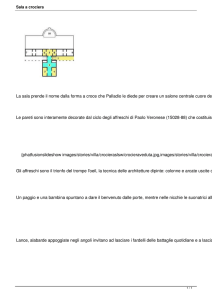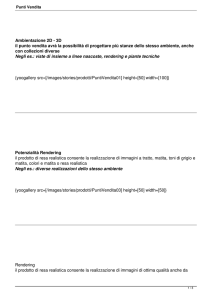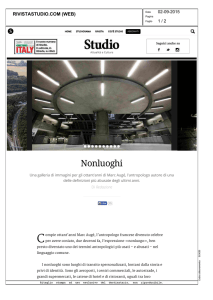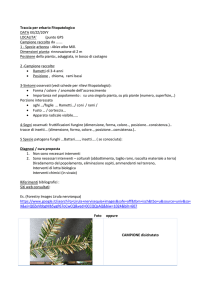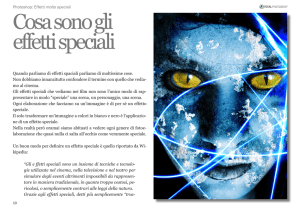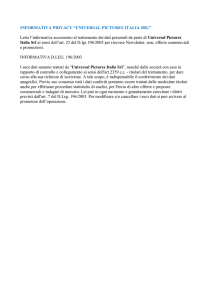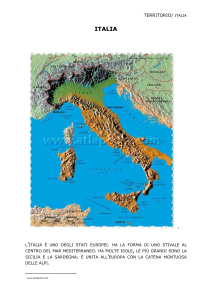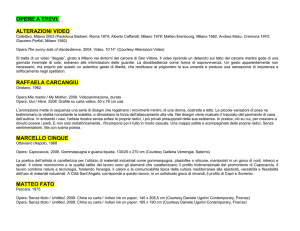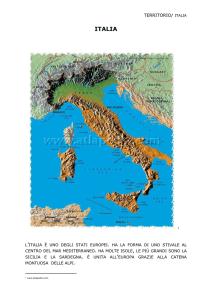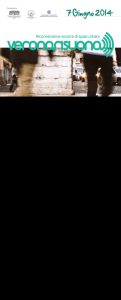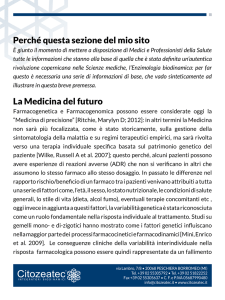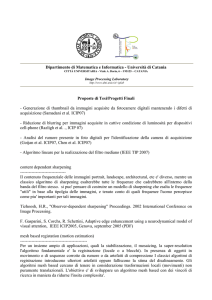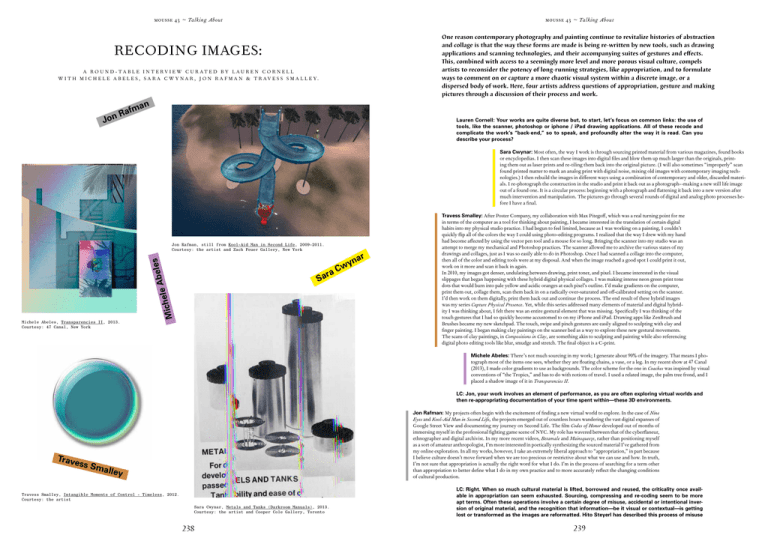
mousse 43 ~ Talking About
mousse 43 ~ Talking About
One reason contemporary photography and painting continue to revitalize histories of abstraction
and collage is that the way these forms are made is being re-written by new tools, such as drawing
applications and scanning technologies, and their accompanying suites of gestures and effects.
This, combined with access to a seemingly more level and more porous visual culture, compels
artists to reconsider the potency of long-running strategies, like appropriation, and to formulate
ways to comment on or capture a more chaotic visual system within a discrete image, or a
dispersed body of work. Here, four artists address questions of appropriation, gesture and making
pictures through a discussion of their process and work.
RECODING IMAGES:
A R O U N D - T A B L E I N T E R V I E W C U R AT E D B Y L AU R E N C O R N E L L
W I T H M I C H E L E A B E L E S , S A R A C W Y N A R , J O N R A F M A N & T R A V E S S S M A L L E Y.
n
Jon
ma
f
a
R
Lauren Cornell: Your works are quite diverse but, to start, let’s focus on common links: the use of
tools, like the scanner, photoshop or iphone / iPad drawing applications. All of these recode and
complicate the work’s “back-end,” so to speak, and profoundly alter the way it is read. Can you
describe your process?
Sara Cwynar: Most often, the way I work is through sourcing printed material from various magazines, found books
or encyclopedias. I then scan these images into digital files and blow them up much larger than the originals, printing them out as laser prints and re-tiling them back into the original picture. (I will also sometimes “improperly” scan
found printed matter to mark an analog print with digital noise, mixing old images with contemporary imaging technologies.) I then rebuild the images in different ways using a combination of contemporary and older, discarded materials. I re-photograph the construction in the studio and print it back out as a photograph--making a new still life image
out of a found one. It is a circular process: beginning with a photograph and flattening it back into a new version after
much intervention and manipulation. The pictures go through several rounds of digital and analog photo processes before I have a final.
eles
Jon Rafman, still from Kool-Aid Man in Second Life, 2009-2011.
Courtesy: the artist and Zach Feuer Gallery, New York
Ab
e
l
e
h
c
ara
Mi
S
Michele Abeles, Transparencies II, 2013.
Courtesy: 47 Canal, New York
r
Cw
a
yn
Travess Smalley: After Poster Company, my collaboration with Max Pitegoff, which was a real turning point for me
in terms of the computer as a tool for thinking about painting, I became interested in the translation of certain digital
habits into my physical studio practice. I had begun to feel limited, because as I was working on a painting, I couldn’t
quickly flip all of the colors the way I could using photo-editing programs. I realized that the way I drew with my hand
had become affected by using the vector pen tool and a mouse for so long. Bringing the scanner into my studio was an
attempt to merge my mechanical and Photoshop practices. The scanner allowed me to archive the various states of my
drawings and collages, just as I was so easily able to do in Photoshop. Once I had scanned a collage into the computer,
then all of the color and editing tools were at my disposal. And when the image reached a good spot I could print it out,
work on it more and scan it back in again.
In 2010, my images got denser, undulating between drawing, print toner, and pixel. I became interested in the visual
slippages that began happening with these hybrid digital physical collages. I was making intense neon green print tone
dots that would burn into pale yellow and acidic oranges at each pixel’s outline. I’d make gradients on the computer,
print them out, collage them, scan them back in on a radically over-saturated and off-calibrated setting on the scanner.
I’d then work on them digitally, print them back out and continue the process. The end result of these hybrid images
was my series Capture Physical Presence. Yet, while this series addressed many elements of material and digital hybridity I was thinking about, I felt there was an entire gestural element that was missing. Specifically I was thinking of the
touch gestures that I had so quickly become accustomed to on my iPhone and iPad. Drawing apps like ZenBrush and
Brushes became my new sketchpad. The touch, swipe and pinch gestures are easily aligned to sculpting with clay and
finger painting. I began making clay paintings on the scanner bed as a way to explore these new gestural movements.
The scans of clay paintings, in Compositions in Clay, are something akin to sculpting and painting while also referencing
digital photo editing tools like blur, smudge and stretch. The final object is a C-print.
Michele Abeles: There’s not much sourcing in my work; I generate about 90% of the imagery. That means I photograph most of the items one sees, whether they are floating chains, a vase, or a leg. In my recent show at 47 Canal
(2013), I made color gradients to use as backgrounds. The color scheme for the one in Coaches was inspired by visual
conventions of “the Tropics,” and has to do with notions of travel. I used a related image, the palm tree frond, and I
placed a shadow image of it in Transparencies II.
LC: Jon, your work involves an element of performance, as you are often exploring virtual worlds and
then re-appropriating documentation of your time spent within—these 3D environments.
Trave
s
Jon Rafman: My projects often begin with the excitement of finding a new virtual world to explore. In the case of Nine
Eyes and Kool-Aid Man in Second Life, the projects emerged out of countless hours wandering the vast digital expanses of
Google Street View and documenting my journey on Second Life. The film Codes of Honor developed out of months of
immersing myself in the professional fighting game scene of NYC. My role has wavered between that of the cyberflaneur,
ethnographer and digital archivist. In my more recent videos, Betamale and Mainsqueeze, rather than positioning myself
as a sort of amateur anthropologist, I’m more interested in poetically synthesizing the sourced material I’ve gathered from
my online exploration. In all my works, however, I take an extremely liberal approach to “appropriation,” in part because
I believe culture doesn’t move forward when we are too precious or restrictive about what we can use and how. In truth,
I’m not sure that appropriation is actually the right word for what I do. I’m in the process of searching for a term other
than appropriation to better define what I do in my own practice and to more accurately reflect the changing conditions
of cultural production.
s Sm
alley
Travess Smalley, Intangible Moments of Control - Timeless, 2012.
Courtesy: the artist
Sara Cwynar, Metals and Tanks (Darkroom Manuals), 2013.
Courtesy: the artist and Cooper Cole Gallery, Toronto
238
LC: Right. When so much cultural material is lifted, borrowed and reused, the criticality once available in appropriation can seem exhausted. Sourcing, compressing and re-coding seem to be more
apt terms. Often these operations involve a certain degree of misuse, accidental or intentional inversion of original material, and the recognition that information—be it visual or contextual—is getting
lost or transformed as the images are reformatted. Hito Steyerl has described this process of misuse
239
mousse 43 ~ Talking About
as images “walking off-screen” and getting “twisted, dilapidated, incorporated and reshuffled.” In
describing the circulation of images, she writes that images “miss their targets, misunderstand their
purpose, get shapes and colors wrong. They go through, fall off, and fade back into screens.” Does
this cycle of misunderstanding and re-coding resonate with you? Or do you feel you are keeping and
commenting on the original meaning and context of the material you use?
MA: I’m intrigued by the idea of images going offline—AWOL. I’ve used that as a starting point for what I’m currently
working on. Thinking about what is then left behind. The idea of movement is worked into the piece Transparencies,
where I traced the contour of a Picabia in oil paint on the glass protecting the photograph. The image from Transparencies
II served as the background in the work. I was trying to bring Picabia’s image from the immaterial realm (digital) into a
physical plane (paint on glass). Of the motifs in Steyerl’s quote, I prefer misuse. In my show Re:Re:Re:Re:Re: I misused
objects—wine bottle, human body, plant. I equated misuse with getting rid of their use value. Without their use value,
they have no context.
LC: Michele, what you say about lack of context and use is interesting. To me, your pieces seem to render such an idiosyncratic informational space: at once personal and totally not, like a desktop-sublime.
Can you talk briefly about the environments your work creates?
MA: It’s just the way I perceive the world. I have a kind of nervousness that leads to rapid juxtapositions. As a result my
images can look like they got lost in the middle of the conversation.
LC: I like that idea of being “in the middle of the conversation.” It implies a kind of freeze frame amidst
a more frenetic environment. Back to this process of misuse and recoding, Sara and Jon, how does
this relate to your work?
SC: I think my work does both. In my works I am trying to foreground the fact that images change without us and that
they often obscure their status as constructions, seeming like presentations of reality even when they are highly manipulated. I am trying to make pictures that show their falseness on their surface. I’m interested in how pictures accumulate,
morph, endure, get away from us and become something different than originally intended. I try to highlight these changes—how images warp with the passing of time and changing trends and with a divorce from original context. It is not
just form that changes as images move through space but also function, value, and use. When Steyerl describes pictures as
“misunderstanding their own purpose, getting shapes and colors wrong, falling off ” she sounds almost as if images have
a life of their own. W.J.T Mitchell in “What Do Pictures Want” also speaks of this—describing images as biological entities that gain value far beyond their worth (for example, religious iconography) or that lose their value completely (for
example, highly stylized commercial images) and live on way past the point where they were made. Steyerl calls the state
of images in our world “a condition partly created by humans but also only partly controlled by them.” We make these
images and then we can’t really control what they do after we make them.
JR: Often my strategy is not so much an attempt to subvert as rather to draw out what I see as the underlying or hidden
potential meanings contained in an image, through a process of reframing, adding text, and re-editing. In my film A Man
Digging, I combined an essay-like voiceover with imagery pulled from the PlayStation video game Max Payne 3. Instead
of quickly moving through the game environments as one typically might, I stopped and lingered on the aftermaths of the
hyperviolent massacres, reflecting on memory and history. Often it only takes a minor intervention or gesture to pull out
a deeper truth contained within an image.
LC: Let’s return to Travess’ notion of gesture, of employing the touch, swipe and brush strokes learned
from iPad/iPhone apps. The artist Ben Thorp Brown recently made work about the corporatization of
these gestures—i.e. the fact that they have been conceived and are being patented by various technology companies. Travess, do you find yourself trying to push outside of these scripted movements, or
are you embracing them? Sara, Michele and Jon, could you talk about the ways you think about this
notion of expressive movement, or gesture, in your work?
TS: I think the same idea of pushing outside of the scripted movements of touch gestures could be applied to my practice
in using Photoshop. Am I critical, and am I aware of Apple’s control in how I interact with their products, or how Adobe’s
programs direct me to be creative and exploit its crazy filters? Am I the programmer or the programmed? I am aware, and
my criticality of the application only becomes present when my work moves out of the program and onto other platforms
and mediums. I think Adobe is very aware of its relationship to all aspects of the art world. I was hardly surprised when
in 2010 Adobe announced its focus on 3D painting tools in the CS 5 release. This announcement came merely a year after
the boom of digital painting that Jon Rafman (as a member of Paint FX) and I (as Poster Company) were part of. I’d say
that I’m working within the realm of what the programmers envisioned. My response to the programming happens when I
try to express the poetic slip-ups I’ve had moving between digital and material states. My response is in trying to replicate
the feeling I had when sitting at my table with pen and paper and slipping between the idea of drawing on a screen and
drawing with a tool.
MA: These companies have nailed us. We can’t resist touching the smooth surfaces of these devices. In retrospect, that
must have affected my decision to apply oil on glass. A desire to bring a literal physicality into my work. I should say that
that piece is an edition of five and I traced the Picabia in order to try to avoid a personal gesture. SC: What interests me most about these scripted movements is the idea that all of these steps go into making a picture
Michele Abeles, Transparencies, 2013. Courtesy: 47 Canal, New York
that hides the fact that it was even “made,” that it doesn’t have a 1:1 ratio with the depicted object. Someone recently said
to me that my works are “honest” pictures—they show their making—like a rejection of the set of tools that imaging
technologies give us, an attempt to work outside the set of things you can do in Photoshop or with a 5D camera, or the
tools that go into making most of the pictures you see. I think of Travess making these swipes and brush strokes; my
gestures are much more clunky, not fluid. It is very obsessive work, working and reworking sections of images, photographing and re-photographing, one gesture reveals almost nothing. The pictures are accumulations of many, many
tiny movements.
241
Above - Sara Cwynar, Acropolis (Plastic Cups), 2013.
Courtesy: the artist and Cooper Cole Gallery, Toronto
Opposite - Jon Rafman, New Age Demanded (Pushed and Pulled Pink
Marble), 2013.
Courtesy: the artist and Zach Feuer Gallery, New York
243
mousse 43 ~ Talking About
JR: Travess’s notion of gesture applies directly to my work as part of the collective Paint Fx, which was heavily influenced
by Poster Company. Using basic consumer paint software, the members of Paint FX explored the expressive possibilities
of a digital painting, trying to develop an anti-illusionist language out of default effects like drop shadow and emboss.
It was simultaneously a performance and a high-speed dialogue on form. In using default effects, we were trying reveal
or lay bare the software that was being used to make the paintings, similarly to how a “real” painter may attempt make
transparent and de-mystify their process. I felt liberated by the limitations of the programs and the fact that I could make
a painting in a few minutes without having to mix colors or wait for anything to dry.
LC: So much of our cultural experience today is mediated by screens, and artwork itself increasingly
seems to take on an aesthetic of flatness. Given your process, how do you define the spatial dimensions of each of your pictures? Are you thinking in terms of a flat plane, or a broader, more variegated
area with more depth?
MA: I think in terms of horizontalism, limited verticality, shallow depth and thin layers. In installation the exhibition walls
serve as a sort of infinite space the works slide across.
SC: I am very drawn to pictures that have a specific depth that studio product shots often have, a seamless backdrop that
allow for only a few feet of depth behind the photographed object. I intentionally confuse depth and surface as another
means of making obvious, throwaway images trickier, slower to read.
TS: Many of my images develop an overall flatness and compositional symmetry from my continuous movement between
the close up “zoom-in” view and the “fit to screen” view. This working process results in printed images with a fidelity
that holds at close inspection but also holds across the room. The resulting images have a shallow depth of field because
in making them I move between the microscopic focus on textures and the overall composition of the full image. There
isn’t much work done at an in-between scale where I might be concerned with how specific sections of the work relate.
I’d guess that this incessant zoom in and out is different from most of the history of painting, where detail work was done
for minutes or hours at a time before walking across the room, redirecting the light, and taking in the whole composition.
JR: I think simultaneously in terms of flatness and depth, much as I think in terms of online and offline, and my series
frequently move between screen-based and physical expressions. In my “New Age Demanded” project, for example, I
shift between the two-dimensional versions of the busts and 3D polyurethane sculptures.
LC: Last, let’s talk about how your works travel across different forms, outside of single images or
works. Travess and Jon, you often carry your pieces between forms: print, sculpture, and online. Can
you speak about how, or if, you disperse a single body of work across multiple forms?
TS: I started digital and over time developed a more interesting and involved relationship with print. As a student, Poster
Company’s physical production was limited to the resources of Cooper Union. We got all we could out of our print labs,
where I got my first taste of experimenting with how digital images have another life off the screen. As the quality of
my prints’ physical production has gotten better and more material specific, I’ve found more of a reason to separate out
these different forms of presentation. I am making these images with the end goal of having a viewer experience them
in person on a material that is not backlit. I want people to have an experience that isn’t tied to the computer screen. If
they can’t experience it in person, I try to present documentation photographs of the prints instead of the digital file that
was used to make the print. Presenting the original digital files is in some ways like showing a sketch. It’s like showing
the coordinates for how the image will exist outside of a projected display. The physical print is the state that the image has arrived at. The print is the state that I most want the viewer to experience. It exists outside of a backlit screen. That being said, I do currently have certain projects that are specifically made for a digital context. In the summer of 2012
I did a project with the online gallery Bubblebyte called “Intangible Moments of Control” that showed a series large buttons I made using shadowing and translucent vector techniques that I have been seeing in website shops. The images are
presented as .png files with transparent background layers. To present these buttons as prints on the wall would be a loss
of the language and experience I am trying to share with the viewer. JR: I’m drawn to how the virtual spills into every aspect of the real and vice versa. And so I try to make work that migrates easily between various forms of media, and in the process points to the blurring line between the virtual and real,
the online and the offline. My digital images function as prototypes for physical objects. And when photographed, my
objects and installations are often mistaken for digital 3D renders.
Travess Smalley, Composition in Clay 34.6, 2013. Courtesy: Higher Pictures, New York
245
Opposite - Jon Rafman, New Age Demanded (Molten Black), 2013.
Courtesy: the artist and Zach Feuer Gallery, New York
246
Above - Sara Cwynar, Tree in Nature (Darkroom Manuals), 2013.
Courtesy: the artist and Cooper Cole Gallery, Toronto
Travess Smalley, Capture Physical Presence #51, 2011.
Courtesy: the artist and Higher Pictures, New York
Travess Smalley, Computer Graphic on Vinyl (1), 2013.
Courtesy: the artist and Cooper Cole Gallery, Toronto
Opposite, Bottom - Michele Abeles,
Coaches, 2013. Courtesy: 47 Canal,
New York. Photo: Joerg Lohse
248
Top - Jon Rafman, stills from Mainsqueeze,
2014. Courtesy: the artist and Zach Feuer
Gallery, New York
249
Bottom - Sara Cwynar, Toucan in Nature (Post
it notes), 2013. Courtesy: the artist and
Cooper Cole Gallery, Toronto
Travess Smalley, Capture Physical Presence #47, 2011. Courtesy: the artist and Higher Pictures, New York
Michele Abeles, Red, Rock, Cigarettes, Newspaper, Body, Wood, Lycra, Bottle, 2011. Courtesy: 47 Canal, New York
RECODING IMAGES:
una tavola rotonda a cura di Lauren Cornell con Michele Abeles, Sara Cwynar, Jon Rafman e Travess Smalley
informativo idiosincratico: personale e al tempo
stesso totalmente impersonale, come uno sfondo sublime per desktop. Puoi parlarci brevemente delle ambientazioni create dalla tua opera?
MA: Riflettono la mia percezione del mondo. Sono
pervasa da una sorta di inquietudine che mi induce
a fulminee giustapposizioni. Il risultato è che le mie
immagini sembrano perdersi nel bel mezzo della
conversazione.
LC: Mi piace questa idea di essere “nel mezzo
della conversazione”. Evoca una sorta di fermoimmagine in un ambiente frenetico. Tornando
a questo processo di uso improprio e di ricodifica, Sara e Jon, vi sembra che sia attinente al
vostro lavoro?
Jon Rafman, still from Kool-Aid Man in Second Life,
2009-2011. Courtesy: the artist and Zach Feuer
Gallery, New York
Uno dei motivi grazie ai quali la fotografia contemporanea e la pittura continuano a scrivere nuove
storie di astrazione e di collage è che queste forme
sono state riscritte dall’introduzione di nuovi strumenti quali le applicazioni per il disegno e le tecnologie di scansione accompagnate dai relativi gesti
ed effetti. Questo dato di fatto, unito a una cultura
visuale che, almeno in apparenza, si è fatta più piatta e osmotica, impone agli artisti di riconsiderare la
potenza di strategie a lungo termine come l’appropriazione, e di formulare nuovi modi di commentare o di catturare un sistema visuale estremamente
caotico in una singola immagine o in un più vasto
e disperso corpus di opere. In questa sede, quattro
artisti si interrogano sull’appropriazione, sul gesto
e sulla creazione di immagini mediante una riflessione comune sulle rispettive prassi artistiche.
Lauren Cornell: Le vostre opere sono molto diverse ma, per iniziare, focalizziamoci sugli aspetti comuni: il ricorso a strumenti come scanner,
Photoshop, applicazioni per il disegno su iphone/iPad. Tutto ciò ricodifica e complica il “backend” dell’opera, per così dire, e altera profondamente il modo in cui è letto. Potete descrivere il
vostro processo ideativo?
Sara Cwynar: Molto spesso il mio lavoro prende
le mosse da una ricerca di materiale stampato su
riviste, libri o enciclopedie. In un secondo momento scannerizzo queste immagini in digitale, le ingrandisco molto rispetto all’originale, le stampo a
sezioni con una stampante laser e infine le ricompongo nell’immagine originale. (Talvolta mi diverto a scannerizzare “impropriamente” il materiale
stampato per alterare una stampa analogica con il
rumore digitale, mescolando vecchie immagini con
le tecnologie di elaborazione digitale dell’immagine
più contemporanee.) Infine ricostruisco le immagini
in vari modi, combinando materiali contemporanei
ad altri più antichi e obsoleti. Fotografo in studio la
composizione e la stampo ottenendo una fotografia
– realizzo un nuovo still life da uno preesistente. È
un processo circolare: si parte da una fotografia che,
rimaneggiata e manipolata in vario modo, dà vita a
una nuova immagine fotografica bidimensionale. Le
immagini sono sottoposte a tutta una serie di manipolazioni digitali e analogiche, prima di giungere a
una forma definitiva.
Travess Smalley: Dopo Poster Company, la mia
collaborazione con Max Pitegoff è stata determinante nello spingermi a prendere in considerazione il
computer come uno strumento di riflessione sulla
pittura: è stato allora che ho iniziato a escogitare un
modo per trasporre alcune “abitudini digitali” nella
prassi fisica che attuo nel mio studio. Ho iniziato a
sentirmi limitato quando, lavorando a un dipinto,
non potevo disporre a mio piacimento dei colori
simultaneamente come quando usavo software di
photo-editing. Mi resi conto che il modo in cui disegnavo a mano era stato influenzato dalla lunga
abitudine di usare la penna digitale su immagini
vettoriali e un mouse. Portare lo scanner nel mio
studio è stato un tentativo di fondere la mia abilità
manuale con la mia conoscenza di Photoshop. Lo
scanner mi consentiva di archiviare i vari stadi dei
miei disegni e collage proprio come su Photoshop.
Una volta scannerizzato un collage al computer, potevo disporre di tutti i colori e gli strumenti di elaborazione digitale. E quando l’immagine era a buon
punto, potevo stamparla, lavorarci ancora un po’ su
e scannerizzarla di nuovo.
Nel 2010, le mie immagini si sono fatte più dense,
in bilico tra disegno, toner di stampa e pixel. Sviluppai un interesse per gli slittamenti visivi che si
verificavano in questi collage ibridi, fisici e digitali. Punti di stampa di colore verde neon che lungo i
bordi di ogni singolo pixel, sfumavano in un giallo
pallido e in tonalità acide di arancione. Realizzavo i
gradienti al computer, li stampavo, li componevo in
un collage, li scannerizzavo di nuovo scegliendo un
settaggio ultra-saturo e calibrato al minimo dello
scanner. Rielaboravo digitalmente le immagini ottenute, le stampavo e continuavo il processo. Il risultato finale di queste immagini ibride fu la mia serie
Capture Physical Presence. Eppure, anche se questa
serie tematizzava molti elementi d’ibridazione tra
materiale e digitale, sentivo che mancava qualcosa,
un elemento gestuale. Più precisamente mancavano
i gesti che mi ero assuefatto a compiere usando i
miei iPhone e iPad. App di disegno come ZenBrush
e Brushes erano diventate il mio nuovo taccuino di
schizzi. Gesti come toccare, sfiorare, picchiettare e
“pizzicare” il display con due dita per variare le dimensioni di un’immagine sono facilmente assimilabili al plasmare la creta e al dipingere con le dita.
Iniziai a dipingere con la creta e la plastilina sul vetro
dello scanner per esplorare queste nuove gestualità.
Le scansioni dei dipinti argillosi che compongono la
serie “Compositions in Clay”, sono in un certo qual
modo affini alla scultura e alla pittura, e, al tempo
stesso, richiamano effetti di foto-ritocco digitale per
sfocare, sfumare, allungare un’immagine. L’oggetto
finale è una stampa cromogenica.
Michele Abeles: Il mio lavoro non presuppone
molta ricerca; genero il 90% circa delle immagini
che utilizzo. Ciò significa che fotografo io gran parte
degli oggetti, che si tratti di catene fluttuanti, di un
vaso o di una gamba. In una recente mostra da 47
Canal a New York (2013), ho realizzato gradienti di
colore usandoli come sfondo. Lo schema cromatico impiegato in Coaches si ispirava all’immaginario
del “viaggio ai tropici”. Ho scelto un’immagine attinente, le fronde di una palma, e ne ho proiettato
un’immagine-ombra in Transparencies II.
LC: Jon, il tuo lavoro coinvolge un elemento
di performance, in quanto sei solito esplorare
mondi virtuali e documentare il tempo trascorso
in queste ambientazioni 3D per riappropriartene.
Jon Rafman: Alla base dei miei progetti c’è spesso
l’eccitazione legata alla scoperta di un nuovo mondo virtuale da esplorare, come nel caso di Nine Eyes
e di Kool-Aid Man in Second Life, frutto di innumerevoli ore di navigazione nelle sterminate lande digitali di Google Street View e di Second Life e della
volontà di documentare il mio viaggio. Il video Codes of Honor è il frutto di mesi di full immersion nel
mondo del professionismo dei videogiochi picchiaduro (fighting game) di New York. Ho vestito i panni
252
del cyberflaneur, dell’etnografo e dell’archivista digitale. In video più recenti, Betamale e Mainsqueeze, invece di pormi come una sorta di antropologo
dilettante, ho cercato di giungere a una sintesi poetica del materiale reperito nel corso delle mie esplorazioni online. Tutte le mie opere, comunque, sono
accomunate da un approccio estremamente disinvolto all’“appropriazione”, in parte perché ritengo
che la cultura non progredisca se facciamo gli altezzosi o se siamo troppo restrittivi nello stabilire cosa
possiamo usare e come dobbiamo usarlo. A dire il
vero, non sono sicuro che “appropriazione” sia il
termine giusto per definire ciò che faccio. Sono alla
ricerca di un altro termine che definisca in maniera
più calzante la mia prassi artistica e che rifletta con
maggiore accuratezza le condizioni variabili della
produzione culturale.
LC: Giusto. Quando il materiale culturale passato al vaglio, preso in prestito e rielaborato
è così vario ed eterogeneo, la criticità un tempo presente nell’appropriazione può sembrare
obsoleta. Vagliare, comprimere e ricodificare
sembrano termini più consoni. Spesso queste
operazioni sottintendono un certo grado di “uso
improprio”, uno stravolgimento involontario o
intenzionale del materiale originale e la presa
di coscienza che l’informazione – visiva o contestuale che sia – rischi di perdersi o di alterarsi in
questo processo di riformattazione delle immagini. Hito Steyerl ha descritto questo uso improprio come un fluire delle immagini “fuori dallo
schermo” per poi essere “distorte, dilapidate, incorporate e rimescolate”. A proposito di questa
circolazione delle immagini, Steyerl scrive che le
immagini “mancano il loro obiettivo, fraintendono il loro proposito, assumono forme e colori
impropri. Così filtrate, scadono, e si dissolvono
nuovamente negli schermi.” Questo circolo vizioso di fraintendimento e di ricodificazione vi
dice qualcosa? Oppure avete l’impressione di
riuscire ad attenervi al significato e al contesto
originario del materiale che usate?
MA: Mi intriga questa idea delle immagini che
finiscono offline – assenti ingiustificate. L’ho usato come punto di partenza per qualcosa a cui sto
lavorando attualmente. Una riflessione su ciò che
lasciamo dietro di noi. L’idea del movimento l’ho
sviluppata in Transparencies, dove ho tracciato i
contorni di un quadro di Picabia con i colori a olio
sul vetro che protegge la fotografia. L’immagine
contenuta in Transparencies II è servita da sfondo
per l’opera. Il mio intento era quello di trasporre
l’immagine di Picabia dalla dimensione immateriale (digitale) al piano fisico (il dipinto su vetro). Tra
i motivi ripresi da Steyerl, preferisco l’uso improprio. Nel mio spettacolo Re:Re:Re:Re:Re: ho usato
in maniera impropria alcuni elementi – una bottiglia di vino, un corpo umano, una pianta. Nel mio
caso, l’uso improprio equivale all’eliminazione del
loro valore d’uso. Senza un valore d’uso, gli oggetti
perdono il loro contesto.
LC: Michele, è interessante quando parli del
venire meno di un contesto e dell’uso. A mio parere, le tue pièce esprimono proprio uno spazio
SC: Penso che il mio lavoro attui entrambe le strategie. Nelle mie opere cerco di far notare come le
immagini cambino senza di noi. Spesso nascondono la loro natura di “costruzioni”, sembrano rappresentazioni della realtà anche quando sono pesantemente manipolate. Io cerco di realizzare immagini
che manifestino in superficie questa falsità. Mi affascina il modo in cui le immagini si accumulano, si
trasformano, sopravvivono, si allontanano da noi e
si evolvono in qualcosa di completamente diverso
rispetto alle intenzioni originarie. Io cerco di evidenziare questi mutamenti – il modo in cui le immagini
si distorcono con il passare del tempo, evolvendo in
un’altra direzione, finendo per dissociarsi dal contesto originario. Non è solo un cambiamento di forma: quando le immagini attraversano lo spazio, il
cambiamento a cui vanno incontro interessa anche
la loro funzione, il valore e l’utilizzo. Quando Steyerl
parla di immagini che “fraintendono il proprio scopo, assumendo forme e colori impropri, dissolvendosi” è come se attribuisse alle immagini una vita
a sé stante. Anche W.J.T Mitchell in “What Do Pictures Want” ne parla in maniera analoga – descrive
le immagini come entità biologiche che assumono
una valenza che trascende il loro valore materiale
(è il caso dell’iconografia religiosa) o che subiscono
una drastica svalutazione (è il caso delle immagini
commerciali altamente stilizzate) pur continuando a
vivere oltre il punto in cui sono state create. Steyerl
definisce lo stato delle immagini nel nostro mondo
come “una condizione in parte creata dall’uomo, ma
in parte controllata direttamente dalle immagini”,
suggerendo che noi non possiamo avere il pieno
controllo sulle immagini che creiamo.
JR: Spesso la mia strategia non consiste tanto in
un tentativo di sovvertire, quanto piuttosto nel cercare di portare alla luce ciò che vedo: estraendo i significati potenziali nascosti nell’immagine mediante
un processo di rielaborazione e rimaneggiamento
con l’aggiunta di un commento testuale. Nel mio filmato A Man Digging, una voce narrante commenta
una serie di immagini tratte dal videogame PlayStation Max Payne 3. Invece di saltare rapidamente da
una videata di gioco a un’altra come si fa di solito,
mi soffermo sulle conseguenze dei massacri ultra
violenti, riflettendo sulla memoria e sulla storia. Il
più delle volte, basta un piccolo gesto e un minimo
sforzo per riportare alla luce la profonda verità che
si cela dietro un’immagine.
LC: Torniamo alla gestualità a cui alludeva Travess: la capacità di toccare, sfiorare, pichiettare
e “pizzicare” il display con due dita per variare
le dimensioni di un’immagine affinata usando le
app dell’iPad/iPhone. L’artista Ben Thorp Brown,
recentemente, ha richiamato l’attenzione sull’appropriazione di questi gesti da parte delle aziende che li hanno ideati e in certa misura brevettati
perché funzionali alla fruizione delle loro tecnologie. Travess, ti sembra di esserti adattato a
questa logica e di averla fatta tua, o avverti delle
resistenze nei confronti di questa gestualità codificata, ridotta a un copione ben preciso? Sara,
Michele e Jon, potete descrivere il ruolo di questo movimento espressivo, di questa gestualità
nella vostra opera?
TS: Credo che l’idea stessa di sottrarmi a questa
gestualità codificata e prevedibile potrebbe essere
applicata al mio modo di usare Photoshop. Sono
davvero critico, e sono ben consapevole del condizionamento esercitato da Apple sulla mia interazione con questi prodotti, o sul modo in cui i programmi della Adobe influenzano la mia creatività
nello sfruttare tutti quei pazzeschi filtri? Sono io il
programmatore o sono a mia volta “programmato”? Divento consapevole di questo condizionamento e assumo una posizione critica riguardo all’uso
di questi applicativi solo quando la mia opera esce
dal programma e approda ad altre piattaforme e si
confronta con altri medium. Credo che Adobe sia
ben consapevole di questa relazione con tutti gli
aspetti del mondo dell’arte. Non mi ha sorpreso che
nel 2010 Adobe abbia annunciato che intendeva focalizzarsi sugli strumenti di pittura 3D in previsione
dell’uscita del CS 5. Questo annuncio è arrivato a
un anno dal boom della pittura digitale a cui noi,
Jon Rafman (in qualità di membro di Paint FX) e io
(come Poster Company) abbiamo contribuito. Vorrei dire che sto lavorando entro i confini di ciò che i
programmatori hanno previsto. La mia risposta alla
programmazione si formula quando cerco di esprimere le “sbandate” poetiche che ho sperimentato
muovendomi tra la dimensione digitale e quella
materiale. La mia risposta consiste nel cercare di replicare il sentimento da me provato seduto al mio
tavolo da lavoro con carta e penna, riflettendo su
cosa comportasse disegnare su di uno schermo e
disegnare con uno strumento.
MA: Queste aziende ci hanno incastrato. Non sappiamo resistere alla tentazione di toccare la superficie liscia di questi dispositivi. In retrospettiva, credo
che la decisione di applicare la pittura a olio sul vetro abbia risentito di queste considerazioni. Credo
che esprima il desiderio di introdurre letteralmente
una dimensione più fisica nella mia opera. Potrei
dire che il lavoro descritto, parte di una edizione in
cinque esemplari, esprime l’esigenza di sottrarmi a
un gesto personale, e anche il ricorso a un’opera di
Picabia va letto in tal senso.
SC: Ciò che mi colpisce di più di questi gesti codificati dalle nuove tecnologie è l’idea che tutte queste
fasi siano funzionali alla creazione di un’immagine
che nasconde l’“atto creativo” da cui ha avuto origine, e che rifiuta di porsi in un rapporto 1:1 con l’oggetto che rappresenta. Recentemente qualcuno mi
ha detto che le mie opere sono immagini “oneste”
– recano traccia del processo creativo che le ha create – un rifiuto nei confronti del set di strumenti che le
tecnologie di elaborazione digitale mettono a nostra
disposizione, un tentativo di operare al di fuori delle
operazioni che si possono compiere in Photoshop o
con una macchina fotografica 5D, evitando di usare gli strumenti con cui è stata realizzata la maggior
parte delle immagini che vediamo. Penso a Travess,
ai suoi colpi e alle sue pennellate; i miei gesti sono
molto più sgraziati, non fluidi. È un lavoro molto
ossessivo, basato sull’elaborazione e sulla rielaborazione di sezioni di immagini, fotografando e fotografando ancora, un solo gesto non rivela niente;
le immagini sono un accumulo di molti, moltissimi
movimenti appena percettibili.
JR: La nozione di gesto espressa da Travess si applica direttamente al mio lavoro come parte del collettivo Paint Fx, pesantemente influenzato da Poster
Company. Usando un software paint di base, i membri di Paint FX hanno esplorato le possibilità espressive di un dipinto digitale, cercando di sviluppare un
linguaggio anti-illusionistico che ricorre a effetti di
default come l’ombreggiatura e il rilievo. Una performance e un dibattito ad alta velocità sulla forma,
al tempo stesso. Usando effetti di default, abbiamo
cercato di svelare o di mettere in evidenza il software usato per realizzare queste immagini, proprio
come un “vero” pittore potrebbe tentare di rendere
trasparente e demistificare il proprio processo creativo. Ho avvertito un senso di liberazione per i limiti
dei programmi e per il fatto che potevo realizzare un
dipinto in pochi minuti senza essere costretto a mescolare i colori o ad attendere che si asciugassero.
LC: Gran parte della nostra esperienza culturale, oggi, è mediata dagli schermi; la stessa
opera d’arte, sembra avere progressivamente
acquisito un’estetica “piana”. A seconda del vostro processo creativo, come definite le dimensioni spaziali delle vostre immagini, le pensate
nei termini di una superficie piana, uniforme,
o come un’area più ampia, variegata, dotata di
maggiore profondità?
MA: Penso nei termini di un’orizzontalità, di una
verticalità limitata, di una profondità non accentuata
e di strati sottili. Nell’installazione, le pareti espositive sono come una sorta di spazio infinito attraverso
cui le opere scivolano.
SC: Sono profondamente attratto dalle immagini
che hanno una profondità specifica che accomuna spesso gli scatti realizzati in studio, una sorta di
fondale uniforme che riduce a pochi centimetri la
distanza tra l’oggetto in primo piano e ciò che sta
253
dietro. Confondo intenzionalmente profondità e superficie come un altro stratagemma per rendere le
immagini ovvie e scontate più insidiose, oggetto di
una lettura meno immediata.
TS: Molte delle mie immagini si sviluppano secondo un criterio di simmetria compositiva piano
favorito da un continuo passaggio dall’inquadratura ravvicinata per il primo piano, “zoom-in”, e l’inquadratura “adatta allo schermo”. Questo processo
compositivo dà come risultato immagini stampate
con una fedeltà che resiste a un’ispezione ravvicinata, ma che balza agli occhi anche osservando
l’immagine dall’altro capo della stanza. Le mie immagini mostrano una ridotta profondità di campo,
perché nel realizzarle mi muovo tra la microscopica
messa a fuoco della trama e la composizione d’insieme dell’immagine a piena grandezza; non c’è
molto lavoro su una scala intermedia in cui riflettere sulla possibile interazione tra specifiche sezioni
dell’opera. Immagino che questo continuo zoomare
avanti e indietro rappresenti una novità nella storia della pittura, dove il lavoro sui singoli dettagli
richiedeva minuti oppure ore, prima che l’artista si
dirigesse all’altro capo della stanza, riposizionasse
l’illuminazione e osservasse da lontano la composizione d’insieme.
JR: Penso simultaneamente nei termini di superficialità e profondità, proprio come penso nei termini
di online e offline, e le mie opere spesso oscillano
tra espressioni fisiche e basate sullo schermo. Nel
mio progetto “New Age Demanded”, per esempio,
oscillo tra due versioni dimensionali dei busti e delle
sculture 3D in poliuretano.
LC: Per finire, parliamo di come le vostre opere attraversano diverse forme, al di fuori delle
singole immagini o opere. Travess e Jon, spesso le vostre opere attraversano diversi stadi di
forma: stampa, scultura, online. Potete raccontare se e come muta l’opera al variare della forma che assume?
TS: Ho iniziato a lavorare nel settore digitale, e
con il passare del tempo ho sviluppato un interesse
sempre più spiccato e coinvolgente con la stampa.
Quando ero uno studente, la produzione fisica di
Poster Company era direttamente proporzionale alle
risorse della Cooper Union. Ottenevamo il massimo
dai nostri laboratori di stampa, dove ho cominciato
a coltivare il mio gusto per la sperimentazione finalizzata a scoprire in che modo le immagini digitali
possano avere una vita fuori dallo schermo. Con il
progressivo miglioramento delle mie stampe, sempre più calibrate sul materiale, ho trovato più di un
motivo per separare queste forme diverse di presentazione. Creavo queste immagini con lo scopo
dichiarato di fornire allo spettatore un’esperienza
visiva diretta su di un materiale che non fosse retroilluminato. Voglio che le persone abbiano un’esperienza che non sia legata allo schermo di un
computer. Se non possono farne esperienza diretta,
cerco di produrre una documentazione fotografica
delle stampe, piuttosto che del file digitale usato
per realizzare la stampa. Presentare i file digitali originali è in un certo qual modo come mostrare un
bozzetto. È come mostrare le coordinate per come
l’immagine esisterà a di fuori di un display. La stampa fisica è lo stadio ultimo del processo di trasformazione dell’immagine. Desidero che lo spettatore
faccia esperienza di quest’ultimo stadio, la stampa.
Qualcosa che ha la sua esistenza al di fuori di uno
schermo retroilluminato.
Detto questo, attualmente ho in corso diversi progetti elaborati appositamente per un contesto digitale. Nell’estate del 2012 ho intrapreso un progetto
con la galleria online Bubblebyte intitolato “Intangible Moments of Control”: mostrava una serie di
grandi pulsanti realizzati con tecniche di ombreggiatura in formato vettoriale che avevo avuto modo di
osservare in alcuni negozi online. Le immagini sono
presentate come file in formato .png su sfondo trasparente. Presentare questi bottoni come stampe
sulla parete avrebbe comportato una perdita del linguaggio e dell’esperienza che sto cercando di condividere con lo spettatore.
JR: Mi intriga l’infiltrazione del virtuale in ogni
aspetto del reale e viceversa. Pertanto cerco di realizzare un’opera che migri agilmente tra medium
diversi, e che in questo processo di transizione attiri
l’attenzione sui confini sfumati e sempre più confusi
tra virtuale e reale, online e offline. Le mie immagini
digitali sono prototipi di oggetti fisici. E in fotografia,
i miei oggetti e le mie installazioni sono spesso confuse con rendering digitali in 3D.

